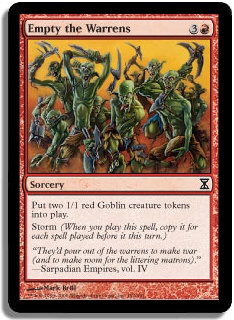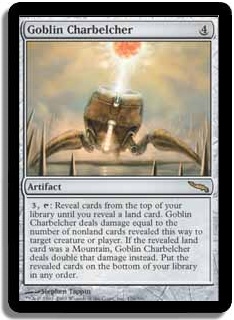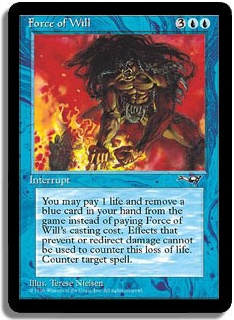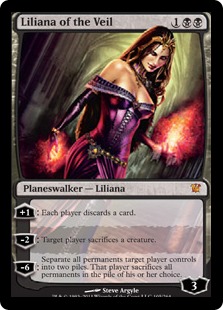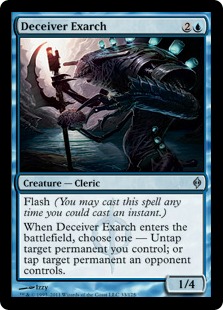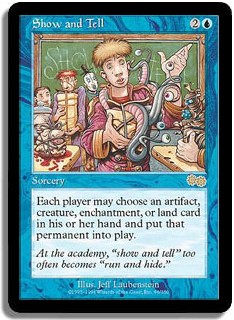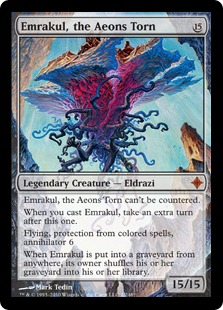Legacy can be hard to get into because it is an unforgiving format. Play the wrong land? Tap out at the wrong moment? Well, you might just be dead. Crack your fetchland too early or get a dual instead of a basic (or vice versa) and you might just never get to the mana you need.
Every play, every decision in this format can and will matter eventually.
You think Legacy looks sweet, but you’re not ready to bear a losing streak until you’ve gotten good at it? There’s an SCG Open coming to your town, and you’d like to play both days but don’t have any experience with the format? In short, you need to start playing Legacy now. You have no time to learn all the intricacies, but you want to do as well as possible in a Legacy event on very little preparation. How are you supposed to do this? The secret is this: choose the right deck. And that decision is what I’m planning to help you with today.
Now, this isn’t going to be a budget article. In this article, I’m going to assume you’ll be able to either borrow or buy the cards necessary to make these decks. They’re beginner-friendly not cash-wise but difficulty-wise.
New To Magic?
Alright, let’s assume you discovered Magic not too long ago and haven’t had the time to build a skill set that will allow you to outplay veteran players. What you want in that situation is a deck that requires as few choices as possible and interacts with the opponent as rarely as possible. After all, if there is no interaction, there is almost no way for your opponent to exploit the skill differential. The deck you should play?
Your sideboard should be fifteen random cards to make believe you’re sideboarding.
Belcher is the ultimate all-in deck. All the deck is geared to do is to present a (hopefully) lethal threat on turn 1 as often as possible, be it a Goblin Charbelcher activation in a deck with zero to one land or a whole lot of Goblin tokens.
The version I’ve presented here was developed by the people that brought Vintage R/G Belcher and cuts the usual Burning Wish plan for extra Empty the Warrens access to straight up make room for more cantrips, a decision they came to after a large number of goldfish games showed that this version of the deck is actually slightly faster than the more business-heavy Wish version.
Basically, what this deck does is allow you to look at your opening hand and check if you can win. You mulligan if you cannot. If the opponent doesn’t have a way to interact with you until the end of your first turn, they’re likely dead (on board).
All you need to do to get said win is to count your available mana sources, see if they add up to enough to cast a big Empty the Warrens or a Goblin Charbelcher (hopefully with mana to activate), and do just that once you’re given the opportunity. Easy as pie.
The problem?
If your opponent counters the correct spell, you’re likely going to be sitting around doing nothing for quite a while. No, this deck doesn’t recover particularly well. In this way, Belcher turns Magic very much into a game of mulliganing. Can your opponent find something to stop you or will you be able to find a hand that can win before their deck is even ready to interact?
This might not sound like the most fun you can have playing Magic if you’re used to playing back and forth games, but at least you get to do something crazy. Having played Belcher in the past, the raw power and speed of the deck makes for quite a bit of adrenaline pumping through your system, though it does lose some of its luster over time.
Most importantly, though, the deck is extremely linear. Your deck has one plan and one plan only, and you can’t really deviate from it. I mean, there’s a reason the above list doesn’t have a sideboard. Almost anything you cut from the deck will end up slowing you down, and given how weak to interaction your plan is, giving the opponent time just isn’t a good idea. As such, if I was to play a tournament knowing that I don’t have the experience I need to outplay people, I wouldn’t even allow myself to be tempted into boarding badly. Just keep your maindeck as is and hope they can’t keep up with your speed.
The straightforward gameplay and mechanics of the deck combined with the incredible amount of raw power means that as long as you understand what you’re supposed to do, you shouldn’t be making many mistakes. And even with Force of Will available, winning on turn 1 is a very hard to deal with threat. In my mind, this is the highest EV deck for any new player entering a Legacy event.
Coming from Modern
These decks are for those of you that haven’t had the chance to get into Legacy but have dabbled in the other formats for long enough to know what you’re doing. If you’ve been playing Modern, for example, you’ve probably gathered quite a bit of experience jamming Deathrite Shamans, Liliana of the Veils, and Bloodbraid Elfs. Luckily for you, Jund is a deck in Legacy, too.
Creatures (16)
Planeswalkers (3)
Lands (23)
Spells (18)
- 2 Lightning Bolt
- 4 Hymn to Tourach
- 1 Forest
- 1 Sylvan Library
- 1 Life from the Loam
- 3 Thoughtseize
- 3 Punishing Fire
- 3 Abrupt Decay
Sideboard

This deck is great for entry-level Legacy players for two reasons. First, it functions as a very basic, straightforward midrange deck. Because this kind of play style is the bread and butter of the smaller formats, you probably have the necessary experience to correctly curve out and use your removal as well as do the relatively simple combat math the deck requires. Jund really is largely point and click Magic.
The two true skill testers in the deck are Liliana of the Veil and targeted discard spells (Thoughtseize and Duress). With the former, the decision of ticking up and discarding or just having it sit there can be tricky—though personally I usually err on the side of going up—but hopefully you’ll have experienced that one in Modern before.
The latter, on the other hand, can be difficult because you need to understand what your opponent is trying to do to pick discards correctly. In fair deck matchups, this isn’t that hard because you should be able to figure out where you’re going from here by looking at your hand followed by taking whatever they have that most severely impacts you game plan. Where this gets difficult is against the unfair decks.
Sure, sometimes they have the obvious hand with lots of mana and a win condition you can snag. At other times, though, you see a hand full of cantrips, disruption, and mana acceleration and need to figure out what they would least like to lose. That can be quite tough, and the only way to really get better at it is to play some games, at least goldfish games, with the combo decks themselves. At the very least, you should scour the Internet for primers on those decks so that you at least have an idea of how they work.
In spite of what I just said, there will be a number of games in which your Hymns just hit perfectly and you’ll easily lock them under Liliana before smashing in with a bunch of Goyfs—your card quality will pay off even against difficult opponents.
In short, what makes Jund a good deck for players looking to get into Legacy is the very intuitive and traditional play style it relies on as well as the high power level of its individual cards.
1 + 1 = Win
Most of you are probably familiar with the Modern Splinter Twin deck. Lots of library manipulation, lots of disruption, and two cards that when put together will just win the game. A deck like this, just like Belcher, has a very straightforward game plan:
Find your two pieces, cast them, win.
Luckily for those among you that want to get the most power with the lowest skill cap, we have a deck that works the same way in Legacy: Sneak and Show. Instead of combining two cards to make an infinite number of cute, small creatures, we just use an enabler to put an unbeatable fatty into play.
Creatures (9)
Lands (15)
Spells (36)
- 4 Brainstorm
- 4 Show and Tell
- 4 Force of Will
- 1 Mountain
- 3 Island
- 2 Intuition
- 2 Misdirection
- 4 Sneak Attack
- 4 Lotus Petal
- 4 Ponder
- 3 Spell Pierce
- 1 Preordain
Sideboard

Now, different from Belcher, this deck isn’t actually all-in on trying to go off as soon as possible, and there are definitely ways for a good player to gain edges that a worse player would miss. The deck has quite a bit of countermagic that you’ll have to use correctly to defend yourself, and there are a lot of cantrips to help you sculpt your hand towards winning—something that will only help you if you make the correct decisions. Even the cantripping is rather straightforward, though: maximize the number of cards you see until you have pieces A and B in hand as well as whatever amount of protection and mana you expect to need. Once you’re there, cast your Show and Tell or Sneak Attack and win.
Luckily for all you new players out there, there are a lot of games where the straight power level of the deck will just carry you. Turn 2 Show and Tell into Emrakul, the Aeons Torn or Griselbrand is just that good.
The fact that this deck uses countermagic to protect itself instead of the discard we see out of Storm decks also helps to make it newcomer-friendly. Whenever they cast a spell, all you need to figure out is if it will keep you from winning or kill you. If it does, counter it. If it doesn’t, ignore it.
In all honesty, I don’t think there’s a better deck out there for someone who knows how to play Magic but is unfamiliar with Legacy. In the same vein, I don’t think there’s a better deck for anyone who believes they will be at a slight skill disadvantage against a lot of their opponents.
Sneak and Show has an extremely high power level, is very linear, and requires significantly fewer and less convoluted decisions than just about any other top tier Legacy deck. There’s also a limited number of cards that can actually interact with it, meaning that there are relatively few cards you have to worry about when making your decisions—which once again helps with making them correctly.
To The Face
Finally, there’s always the option of going straight for the throat the old-fashioned way. Traditionally, this would mean Mono-Red Burn, but right now there’s a little too much combo running around for me to suggest playing that deck. Here’s what I believe you should be running instead if getting in for damage as fast as possible is your thing:
Creatures (15)
Lands (15)
Spells (30)
- 4 Brainstorm
- 4 Lightning Bolt
- 4 Force of Will
- 2 Mountain
- 2 Island
- 4 Chain Lightning
- 2 Price of Progress
- 2 Daze
- 3 Ponder
- 3 Spell Pierce
Sideboard

UR Delver is essentially a burn deck in disguise. By sacrificing some of the consistency of running nothing but direct damage as the Mono-Red deck would, you gain access to library manipulation to win back that lost consistency as well as some countermagic to make sure the game actually gets to turn 4 or 5—which is when you hope to be approaching twenty.
Once again, what makes this deck a good choice for someone new to Legacy is its single-minded focus. What you want to do is maximize your damage output every step of the way. Deploy your creatures, use your countermagic and burn to keep blockers and other hindrances—like removal or a combo win—at bay, and once they get low enough lob the remaining red spells at their head to end things.
In General
Alright, enough about my direct suggestions. These four decks are well-established players in Legacy and have proven that they can succeed more than once. They also share a number of characteristics that make them good choices for anyone looking to get into the format.
They are by no means the only ones, though. Merfolk, for example, is another deck that is a great choice for someone who wants to get into the format and not do a lot of losing to start off.
What’s left for us to do is to discuss the characteristics I look for in a deck to determine it new player-friendly. That way you’ll be able to figure out which of your decks you should hand to a friend that wants to join your local Legacy tournament for the first time. Or if you are said friend, you’ll know what kind of deck to look for if you plan on dipping your toes into the water but don’t have the card pool to build anything I mentioned above. Alright, let’s get to it.
The first thing you should realize when looking at the decks above is that they all have a very proactive game plan. Belcher just kills you, Show and Tell does the same while protecting itself, Jund puts on pressure while ripping apart the other side’s hand and board, and U/R Delver swings and burns until the opponent dies.
What all this means is that you really don’t need to know too much about what your opponent is doing. As long as it doesn’t hold you back or kill you, you don’t really care. You don’t have to worry about finding the wrong answer at the wrong time. All you care about is getting to do your thing for long enough to win.
There’s a reason control decks usually take a while to become successful after a Standard rotation: a control deck needs to know what’s out there to pack the right answers. Similarly, the more controlling and reactive a deck becomes, the more knowledge of the opponent’s capabilities is necessary to succeed with the deck. And that knowledge is exactly what a player new to Legacy is missing, hence why you should be going for something with a strong proactive game plan.
The second characteristic I look for is linearity. To a certain extent, this criterion goes with the proactive game plan. If your deck is very linear, you’ll generally be trying to advance the game. There is more to this, though. As your game plan becomes more linear, the opponent’s cards start to matter less. Belcher is obviously the most extreme example here because it is a deck that usually cares about nothing but Force of Will (or Mindbreak Trap) when on the play.
Finding a deck this non-interactive is pretty rare, but every viable deck has the ability to blank opposing cards to a certain extent. And the more cards you blank, the fewer cards will be able to surprise you and cost you games. Essentially, you want to be playing a very linear deck when you’re new to the format because that way you need to know and play around fewer cards. With a card pool as large as that of Legacy, that’s an edge you shouldn’t be giving away.
Finally, these decks aren’t tricky. They were chosen in a large part for how easy they are to play. None of these decks has a multitude of options, tricky interactions, or intricate lines of play it needs to follow with regularity.
Having a straightforward deck is a big boon when you’re entering a play environment you’re unfamiliar with. First, there are fewer traps you can run into unknowingly. If your deck requires you to play in a certain way, you know what you did was correct even if your opponent happened to have the correct answer. If your deck gives you a dozen different ways to get to a desired result, on the other hand, you’re likely to choose the wrong one without enough experience.
Even more importantly, your deck being relatively easy to play allows you to focus your attention elsewhere—namely over on your opponent’s side. There are a lot of decks in Legacy that will set up convoluted shenanigans and weird loops or that will pull off surprising role reversals. If you’re new to the format, a lot of those things might catch you by surprise and cost you the game. The best way to avoid this—aside from getting to know the format—is to have as much of your focus as possible on your opponent’s cards. Try to figure out what they’re doing, what it is they’re setting up, and which cards they might have that will suddenly allow them to Voltron up and take the game. You can only do that, though, if your own deck doesn’t take up too much mind space.
Get Started
So this is what a deck for someone who is new to Legacy should look like: easy-to-play, high-powered, proactive game plan, and as non-interactive as you can possibly make it. Yeah, I know, sorry for all of you control lovers out there; the things you we like simply don’t make for a high success rate if you don’t know a format well.
Actually, those criteria apply to more than just getting into Legacy. Whenever you plan on playing a new format, choose a deck that has those characteristics. After all, what I said for Legacy is largely true for just about any unknown format. You can’t play around what you don’t know, so killing your opponent is the best way to beat whatever strange plans they have.
I hope you enjoyed this article; maybe I’ll even help some of you do well at your first outing in the Legacy format. If you actually run one of these in your very first Legacy tournament, feel free to share the experience in the comments—I’m hoping for some happy first place stories!
Until next time, try something new!

